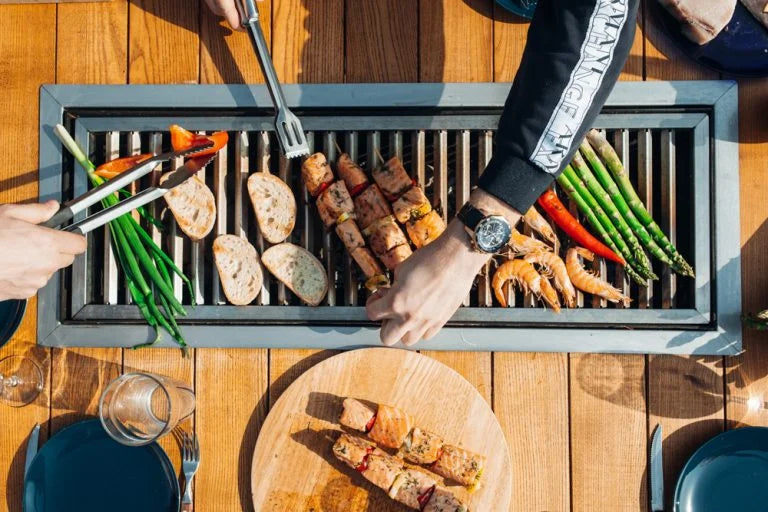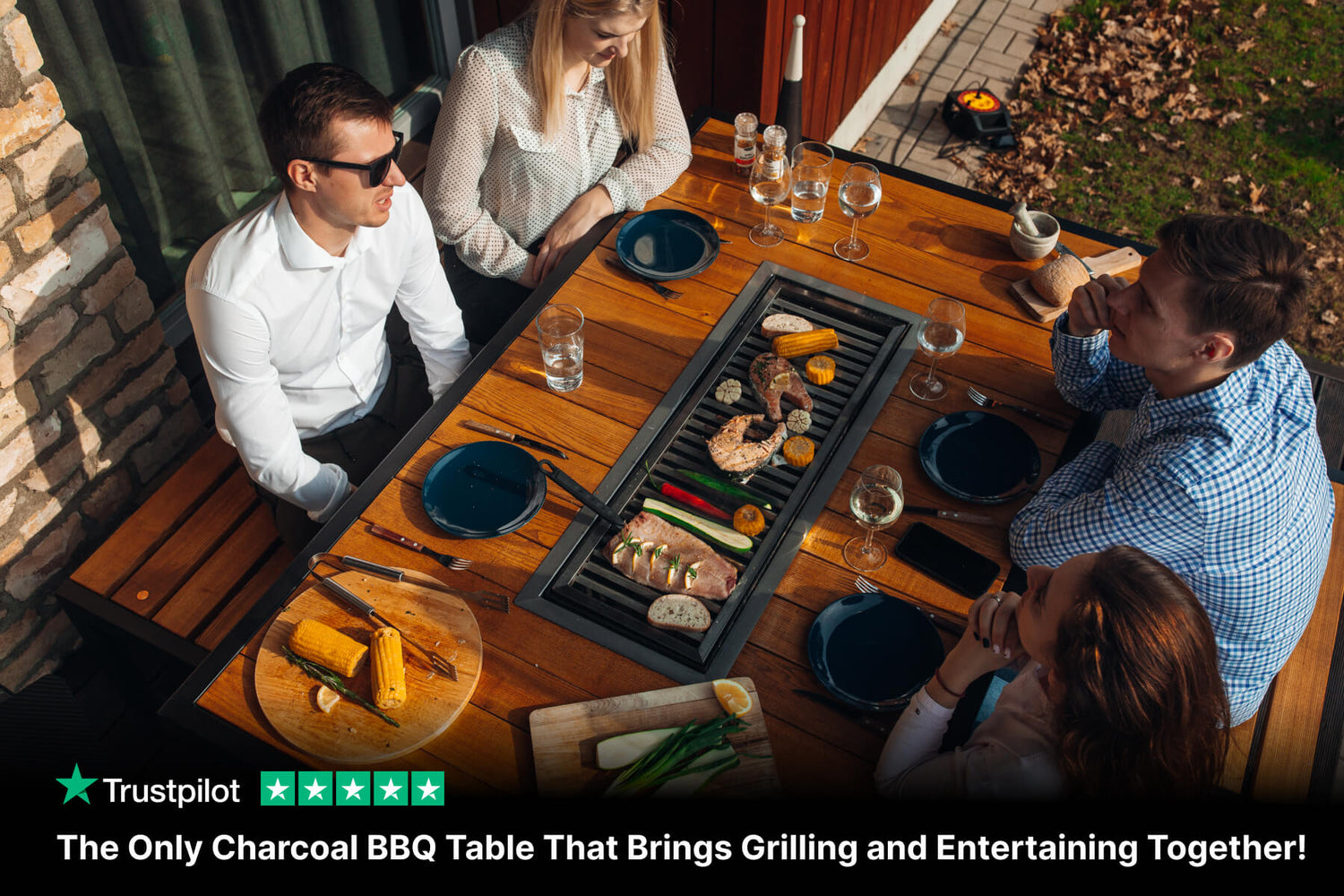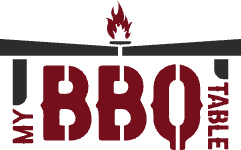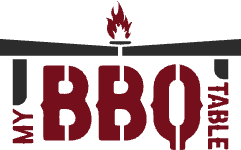
Charcoal Grilling 101
Share
Garden barbecue parties, friends and family all being together.
The taste and the smell of freshly cooked meat and vegetables straight off the charcoal BBQ. There’s something very special about all of that, something to cherish and yearn for. If this is also something that you would like to try out, then this a guide for you. That’s charcoal grilling for beginners and those still thinking of trying it out, or in other words — charcoal grilling 101.
Basics of grilling and the best tips on charcoal grilling in a single guide.
Save this guide for later, if you don’t own a grill just yet.
Charcoal Grilling 101: Basics of Grilling
Choosing the right fuel, lighting the charcoal, cooking yourself a delicious meal and cleaning the grill quickly and easily — that’s charcoal grilling 101.
1. Grill Types
There are several types of grills available.
There are gas grills, charcoal grills, pellet grills, infrared grills, electric grills and hybrid barbecue grills, to name a few of the most popular options. Each one of these grills have their own characteristics and aspects of use.
Gas and electric grills are known for their ease of use. They’re easy to light and it’s very easy to control the temperature. Also gas grills heat up quickly and require little cleanup. There are also countertop electric grills which are perfect for indoor use (can be used in an apartment).
Charcoal grills, however, are known for versatility. You can cook almost anything on a charcoal grill. They are also very easy to install and provide a unique smoky flavour to your foods. The latter being one of the main reasons why people choose charcoal over gas. Charcoal grills are less complicated than gas grills or electric grills, thus they are also significantly cheaper.
With charcoal grills you get a much better product for the same price.
2. Why Choose a Charcoal grill?
Just in case you still haven’t decided.
As with everything else, charcoal grills have both advantages and disadvantages. The reason why so many choose a charcoal grill is the signature smoky flavour charcoal grills provide.
Other reasons why to choose a charcoal grill:
- Charcoal burns hotter than gas;
- It’s safer as there’s no open flame, only glowing embers;
- You get more for your money;
- Charcoal grills are simpler, and simple design means simpler use and maintenance.
2.1 Why Choose My BBQ Table?
There are many reasons to love My BBQ Table sets.
It’s one of the best gifts for BBQ lovers that you can buy online.
First of all, thanks to the smart design of My BBQ Table tables, everyone sitting at the table can cook their own food. Secondly, the grill is large enough to cook several different types of foods all at the same time — meat, fish, vegetables, omelette (using a frying pan) and even a pizza. Last but not least, it makes every occasion even more fun for everyone, everything from Sunday brunches with family to bbq parties with friends.
Choosing the best grill for your needs is just as important as learning how to cook with charcoal.
See also: 7 Reasons to Love My BBQ Table
3. Choosing the Right Fuel for Your Charcoal Grill
What’s the best charcoal for grilling?
And, again there are several options. Regular lump charcoal and charcoal briquettes are two of the most popular options, and we recommend charcoal briquettes in combination with wood chips / firewood (used only to start a grill).
Charcoal briquettes burn longer and maintain a steady temperature for a longer period of time than regular lump charcoal. True, they are a harder to ignite, but at the same time require no extra work from you afterwards. All My BBQ Table sets come with a free pack of charcoal briquettes and firewood, so you can try them out for yourself.
As our experience with My BBQ Table shows, a 2-kg bag of charcoal briquettes and a 2-kg bag of firewood is enough for a 5-hour long grilling session.

4. How to Start a Charcoal Grill?
There are several ways how to start a charcoal grill.
One of the easiest ways is by using a lighter fluid. It’s extremely easy, fast, efficient, and when done properly also doesn’t affect neither taste nor smell of the food. Just pour in the charcoal or briquettes, cover them with some firewood or wood chips, pour over with a little bit of lighter fluid and light it a couple of minutes later.
Some BBQ enthusiasts do not recommend using lighter fluid for barbecue, because of the taste it might give and the chemicals it consists of. The key here is to let the fire to go on for at least 15 – 20 minutes, for all the firewood to burn up, and accordingly for the fumes of the lighter fluid to dissolve as well. The wait is also necessary for the charcoal to be ready to be cooked on.
And, of course, don’t use too much of the fluid.
It’s also possible to light charcoal without lighter fluid.
4.1 How to Light Charcoal Without Lighter Fluid?
Most people choose to light charcoal with lighter fluid.
It shouldn’t come as a surprise, as it’s extremely easy, fast and efficient. When done properly, it’s also doesn’t affect the taste and overall is a great way to start a charcoal grill. But what if you don’t have a lighter fluid or if don’t want to use it? How to light charcoal without lighter fluid?
There are several ways you can light charcoal without lighter fluid.
It may require more patience or time, but it’s absolutely doable.
You can use:
- electric charcoal grill fire starter;
- chimney starter;
- fireplace lighter cubes;
- paper and dry sticks.
5. When Is Charcoal Ready to Cook On?
How long does it take for charcoal to be ready?
It depends on the grill and the type of charcoal.
Simply wait until all the firewood has burned up and most of the charcoal has turned either white or grey. With My BBQ Table grills, and using lighter fluid, it takes around 15 – 20 minutes. After that the grill is ready for cooking. If you’ll be starting a grill without a lighter fluid, plan more time.
5.1. How Long Does Charcoal Stay Hot?
It can be anything from 1 hour to up to 5 or more hours.
It depends on the grill, the amount of charcoal used and several other factors. If you want to take the easiest path, choose charcoal briquettes — they burn significantly longer, and require little to no extra work once the coals are ready to be cooked on. Accordingly your grill will stay hot longer.
Read more: How Long Does Charcoal Last?
6. Mastering Two-Zone Grilling
It’s easy, and it will allow you to control the heat.
It’s also one of our top charcoal BBQ tips. Arrange the hot coals on one side of the grill only. Leave the other side coal free. This will provide extremely hot temperatures on one side and cooler temperatures on the other. Use the hot side for searing and fast cooking, the one without the coals — for slower, indirect cooking. Use it to cook foods through after searing. Even though there are no coals underneath, it’s still hot and food will cook there, just not as fast as on the other side.
7. How to Prevent Flare-ups?
Follow these easy steps to prevent flare-ups:
- Remove excess fat, sauces or marinade before BBQ grilling;
- Don’t oil the grate, coat your food with a thin layer of oil instead;
- Don’t over-oil your food;
- Avoid wind;
- Leave one side of the grill coal free, so you can move your food there in case of flare-ups;
- Do a light clean-up after every grilling session. Clean your grill to remove food residue and old grease.
See also: Charcoal Grilling Safety Tips
7.1 How to Put Out a Flare-Up?
Move the dripping food to the coal free part of the grill and let the flare-up subside.
Close the lid to cut off the oxygen (if there is a lid).
Never use water to put out a fire!
 Cooking fish on a charcoal grill
Cooking fish on a charcoal grill
8. What Can You Cook on a Charcoal Grill?
What you can cook on My BBQ Table grills? Just about anything!
Charcoal grills are well-known for versatility. You can use one for anything from breakfast with family to full-on BBQ party with friends, cooking anything from steaks and burgers to fruits and light veggie snacks. Meat and seafood cooked on a charcoal grill will taste great —grilling over charcoal gives the meat and fish that wonderful smoky flavour.
Fish, prawns, lobster, crab and other seafood can be easily cooked on a grill. The best fish for grilling? Tuna, salmon, cod, sea bass and red snapper are all great options. Choose which type of fish cut you want to prepare — fillet, steak or whole fish.
You can also grill vegetables on a charcoal grill.
Here are just a few ideas:
- Grilled corn on the cob
- Grilled avocado with tomatoes and herbs
- Grilled cabbage
- Grilled baby potatoes with rosemary
- Grilled whole cauliflower
- Grilled glazed pineapple
- Grilled figs with crème fraiche and honey
- Grilled bananas with chocolate coating (you can melt chocolate on the grill, in a small saucepan)
You can even grill fruit such as pineapples, cantaloupes, oranges, peaches, bananas and even strawberries. As long as they’re firm and not overripe. Just spray a little coconut oil on them before grilling and drizzle fruits with maple syrup or honey at the end.
It may surprise you, but you can make a pizza on a grill.
Cooking pizza on charcoal grill is, actually, very easy. Especially if you’re going to use a ready made pizza base.
Put the dough or the pizza base on the pan or directly on the grill grates (they must be greased) cook it on both sides. Take it off, cover with a little bit of olive oil, then cover it with tomato puree. Sprinkle on your toppings, ending with cheese. If you use meat, it must be pre-cooked. Finish cooking on the grill or pan.
What about vegetarian food?
There are countless charcoal grilling recipes for vegetarians. Grill vegetables for salads. Make veggie burgers or plant based Beyond burgers. Make a grilled cheese sandwich — grill the bread on both sides, and cheese separately from the bread, then assemble the sandwich.
8.1 What Do I Put On a Skewer?
Just about anything can be put on a skewer.
Different types of meat and fish, pieces of meat with vegetable chunks between them, or only vegetables. Speaking of vegetables, we recommend you to cut vegetables into large chunks. So they are seared on the outside but don’t go too soft on the inside. If you cut your veggies too thin, they will easily burn.
What if you don’t have skewers?
What can be used as substitutes for skewers?
Lemongrass stalks make excellent substitutes for skewers. You can use them for chicken, shrimp or fish. You can also put chunks of meat on fresh rosemary, if you would like a hint of rosemary. Put red meat and fruit on cinnamon sticks.

9. Clean the Grill Grate After Every Use
The grate is the part of the grill that you place your food on.
That’s the only part of the grill that comes in contact with the food. Hence it’s important to keep it clean, that’s BBQ 101. You don’t have to clean the whole grill after every use, but we would recommend you to take care of the grate. Otherwise your food will stick to the food left from the last grilling session, and you don’t want that to happen.
10. How to Clean a Charcoal Grill?
Brush the grate with a grill brush.
Do it soon after you’ve finished cooking. Then let your grill cool down and brush the grate one more time to get rid of the last bits of food that may still be there. Wash the grate, if necessary. It’s easier to do it while it’s still warm. You can use a special cleaner or make your own from water and vinegar. Spray the grates with the cleaner. Let it sit for some 10 – 15 minutes. Afterwards clean it off with a cloth or sponge.
Empty the grill of all ash once in a while.
Once in a while every barbecue grill needs a deep cleaning.
What if the grill is clean but food still sticks?
Rub a little oil on the grates.
See also: How to Clean a Charcoal Grill?
11. What to Do With Charcoal After Grilling?
If you use additive-free charcoal, you can use it as fertiliser.
The ash contains potassium carbonate, which is nutritious for plants.
If you are using charcoal briquettes which contain additives, throw them in the rubbish bin after use. They can’t be used as a fertiliser, as they are not fully natural. Just make sure they are completely cool when you throw them out.

12. How to Tell if Meat Is Cooked?
How to tell if chicken is done?
How to tell if salmon is done?
Use a thermometer when cooking meat.
That’s the easiest and best way to tell the meat is cooked properly. You can’t tell if the meat is cooked or no just by cutting into it or poking it, especially if you aren’t experienced with barbecuing. Google the type meat you’ll be cooking to learn what’s the right temperature for it.
When using a meat thermometer, clean it in between uses to avoid cross-contamination in case the meat has not yet reached a safe temperature when you were checking it.
13. How to Avoid Cross-Contamination?
You’d want to avoid that!
Cross-contamination can occur when you use tools (tongs, basting brushes, meat thermometer, etc.) on raw meat without thoroughly washing them when touching cooked meat. Please, try to avoid that, and you’ll have a better chance at avoiding cross contamination while grilling.
14. Accessories for Grilling
Get them for yourself or your BBQ loving friend.
Here’s a list of some of the most popular accessories for grilling we would recommend you to use. Add them to your BBQ shopping list, and have fun on your next BBQ party.
- Stainless steels barbecue skewers — a must for every grilling enthusiast;
- Electric charcoal grill fire starter — an easy and fast way to start your grill;
- Meat thermometer — fast and accurate way to tell if the meat is cooked;
- Grill brush — a must have for all grill owners;
- Grilling tool set that include tools such as barbecue fork, steel tongs, spatulas, silicone basting brush. Rather than buying grilling tools by the piece, opt for a grilling tool set. Thus you’ll never be without the right utensil for the job;
- BBQ multi-tool — a good alternative to a grilling tool set, one handy tool which often includes: meat fork, spatula, tong, silicone basting brush;
- Grilling pan — so that vegetables and other small food items stay in place while grilling and do not slip through the grill grates;
- Grill fish basket — keeps your fish and other seafood from sticking to the grates of the grill (don’t forget to oil the fish basket);
- Hinged grill basket — keeps vegetables contained, you can easily cook them from both sides just by flipping the basket;
- Meat injector — for injecting marinades into the meats for a better flavour;
- Meat claws — for handling, shredding and carving meat;
- Kabob grilling baskets — steel-wire, non-stick baskets for cooking kabobs without a skewer.

Happy grilling!



